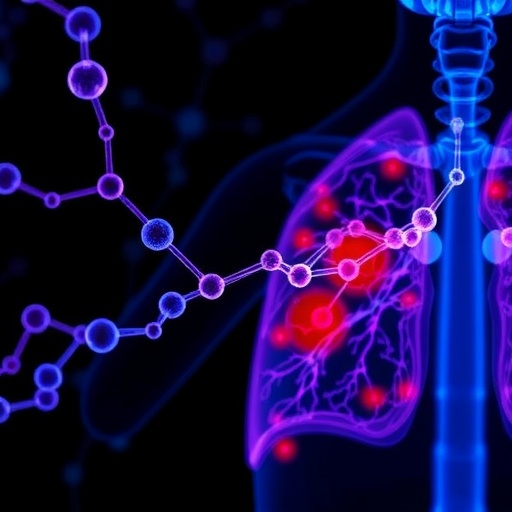A pioneering breakthrough in cancer therapy has emerged from the laboratories of the Korea Research Institute of Bioscience and Biotechnology (KRIBB), where a team led by Dr. Juyeon Jung at the Bio-Nano Research Center has developed a revolutionary nanobody-based technology that offers unprecedented precision in attacking lung cancer cells. This novel approach employs a uniquely engineered nanobody capable of identifying and targeting lung adenocarcinoma cells, one of the most challenging and prevalent subtypes of non-small cell lung cancer (NSCLC). By minimizing the collateral damage typically associated with conventional chemotherapy, this advancement holds potential to redefine treatment paradigms for lung cancer and beyond.
Lung adenocarcinoma remains a notoriously aggressive and deadly form of cancer, representing over 50% of all lung cancer diagnoses worldwide. Its insidious nature, marked by late-stage detection and a high propensity for recurrence, has historically limited therapeutic success. Standard chemotherapy regimens, though somewhat effective, tend to indiscriminately assault both malignant and healthy cells alike, resulting in debilitating side effects including hair loss, nausea, immunosuppression, and compromised patient quality of life. Furthermore, the inefficiencies in targeted drug delivery often diminish the potency of these treatments, underscoring the urgent need for more sophisticated therapeutic modalities.
In addressing these critical challenges, the KRIBB team has innovated the A5 nanobody, a miniature and highly specific antibody fragment engineered to bind selectively to CD155, a protein ubiquitously overexpressed on lung cancer cells but scarcely present on normal tissues. Unlike conventional antibodies, which are considerably larger, the A5 nanobody is approximately ten times smaller, endowing it with superior tissue penetration capabilities. This compact structure not only enhances its ability to navigate the complex microenvironment of tumors but also optimizes binding affinity, ensuring that the therapeutic agent homes in exclusively on malignant cells.
.adsslot_GwazJb61YO{ width:728px !important; height:90px !important; }
@media (max-width:1199px) { .adsslot_GwazJb61YO{ width:468px !important; height:60px !important; } }
@media (max-width:767px) { .adsslot_GwazJb61YO{ width:320px !important; height:50px !important; } }
ADVERTISEMENT
Integral to the therapeutic function of the A5 nanobody is its capacity to inhibit critical processes in cancer progression. Laboratory investigations have demonstrated that the A5 nanobody effectively suppresses lung cancer cell migration and invasion by over 50%, mechanisms central to metastasis formation and disease advancement. This functional blockade serves as a potent therapeutic intervention point, potentially stalling tumor spread at an early stage and improving clinical outcomes.
Expanding upon this targeting mechanism, the researchers engineered an advanced drug delivery system dubbed A5-LNP-DOX, wherein the A5 nanobody is conjugated to liposomal nanoparticles encapsulating doxorubicin (DOX), a widely used and potent chemotherapeutic agent. The use of liposomes serves a dual purpose: it protects the encapsulated drug from premature degradation and enables controlled release within the tumor microenvironment. The conjugation with the A5 nanobody ensures that these liposomes specifically dock onto CD155-expressing cancer cells, facilitating a “guided missile” or “drone strike” approach to chemotherapy administration.
The therapeutic promise of A5-LNP-DOX extends beyond cell cultures; it has been rigorously evaluated in vivo across animal models and patient-derived organoids, systems that faithfully recapitulate human tumor biology. Results demonstrated a remarkable 70 to 90 percent reduction in tumor burden, coupled with elevated markers of cancer cell apoptosis and necrosis. Importantly, these outcomes were achieved without detectable adverse effects on critical vital organs such as the liver, heart, and kidneys, reinforcing the safety profile of this nanobody-guided chemotherapeutic strategy.
Central to this breakthrough is the selective targeting of CD155, also known as the poliovirus receptor, whose overexpression in lung adenocarcinoma offers an exploitable vulnerability. Its role in tumor immune evasion and cellular adhesion makes CD155 an attractive target for therapeutic interference. The innovative binding specificity of the A5 nanobody towards this target enables precise intervention within oncogenic signaling pathways while minimizing off-target interactions that have plagued earlier treatments.
Beyond its immediate application to lung adenocarcinoma, this nanobody-based platform is poised for broad-spectrum adaptability. Dr. Juyeon Jung emphasizes the versatility inherent in the technology, envisioning its adaptation to other cancer types characterized by distinct surface markers, thus inaugurating a new era of precision medicine. The capacity to engineer nanobodies against a multitude of tumor-associated antigens holds promise for tailored therapies that maximize efficacy and patient tolerability.
The development process also reflects an elegant integration of biotechnology and nanomedicine, domains rapidly converging to revolutionize modern therapeutics. The liposomal drug carriers combined with compact, high-affinity nanobodies exemplify how biomolecular engineering can enhance pharmacodynamics and pharmacokinetics concurrently. These advances collectively pave the way for therapeutic regimens that can be finely tuned to individual patient tumor profiles, elevating personalized medicine from concept to clinical reality.
Funding and support from the Ministry of Science and ICT (MSIT), the Korea Agency of Education, Promotion and Evaluation for Food, Agriculture, Forestry and Fisheries (IPET), and the KRIBB Research Initiative Program have been instrumental in driving this research. The collaborative nature of this endeavor underscores the significance of sustained investment in cutting-edge basic and translational science, which continues to yield innovations capable of dramatically improving cancer care trajectories.
Published in the highly acclaimed journal Signal Transduction and Targeted Therapy on July 10, 2025, this landmark study entitled “Targeting CD155 in lung adenocarcinoma: A5 nanobody-based therapeutics for precision treatment and enhanced drug delivery” sets a new benchmark in oncology drug design. The high impact factor of the journal attests to the global relevance and timely nature of this work, signaling robust peer validation within the scientific community.
In summary, the advent of the A5 nanobody and its integration into targeted liposomal chemotherapeutics represents a transformative strategy in lung adenocarcinoma treatment. By offering a mechanism to not only selectively identify but also effectively neutralize cancer cells with minimal collateral damage, this technology exemplifies the future of oncology – one characterized by precision, efficacy, and patient-centered care. Continuing clinical development and eventual translation into therapeutic applications could profoundly alter the prognosis for patients suffering from lung cancer worldwide.
Subject of Research: Nanobody-based targeted therapy and drug delivery for lung adenocarcinoma focusing on CD155 protein.
Article Title: Targeting CD155 in lung adenocarcinoma: A5 nanobody-based therapeutics for precision treatment and enhanced drug delivery
News Publication Date: 10-Jul-2025
Web References: http://dx.doi.org/10.1038/s41392-025-02301-z
Image Credits: Korea Research Institute of Bioscience and Biotechnology (KRIBB)
Keywords: Lung adenocarcinoma, nanobody, CD155, targeted therapy, doxorubicin, liposomal nanoparticles, precision medicine, KRIBB, drug delivery, cancer metastasis, antibody engineering, non-small cell lung cancer
Tags: breakthrough cancer therapiesengineered nanobody technologyenhancing targeted drug deliveryKRIBB cancer researchlung cancer research breakthroughslung cancer treatment advancementsminimizing chemotherapy side effectsnon-small cell lung cancer innovationsprecision medicine in oncologyprecision nanobody therapytargeting lung adenocarcinomatherapeutic modalities for cancer





